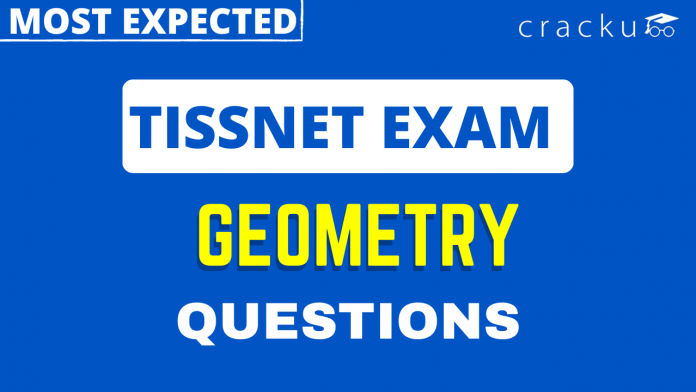TISSNET Geometry Questions PDF [Most Importat Quant Questions]
TISSNET Geometry questions with a PDF by Cracku. Practice TISSNET solved Geometry Questions paper tests, and these are the practice question to have a firm grasp on the Geometry topic in the TISSNET exam. Very Important Geometry Questions for TISSNET based on the questions asked in the previous TISSNET exam papers. Click on the link below to download the TISSNET Geometry Questions with answers PDF.
Download Geometry Questions for TISSNET
Enroll to TISSNET 2023 Crash Course
Question 1: ABCD is a trapezoid where BC is parallel to AD and perpendicular to AB. Kindly note that BC< AD. Pis a point on AD such that CPD is an equilateral triangle. Q is a point on BC such that AQ is parallel to PC. If the area of the triangle CPD is $4\sqrt{\ 3}$, find the area of the triangle ABQ.
a) $2\sqrt{3}$
b) $4\sqrt{3}$
c) 4
d) $8\sqrt{3}$
e) None of the above
1) Answer (A)
Solution:
Given that, CPD is an equilateral triangle

$\angle\ CPD=\angle\ PDC=\angle\ DCP=60^{\circ\ }$
As AQ is parallel to PC $\angle\ CPD=\angle\ QAP=60^{\circ\ }$
As BC is parallel to AD $\angle\ QAP=\angle\ AQB=60^{\circ\ }$ ( alternate interior angles).
Given, Area of equilateral triangle CPD is $4\sqrt{\ 3}$
This implies, $\ \frac{\ \sqrt{3}a^2}{4}=4\sqrt{3}$
Solving, we get $a=\ 4$.
From figure, length of $AB$ = Height of $\triangle\ CPD=\frac{\sqrt{\ 3}a}{2}=2\sqrt{\ 3}$.
From $\triangle\ ABQ,\ BQ=\ \frac{\ AB}{\tan\ 60^{\circ\ }}=\frac{2\sqrt{\ 3}}{\sqrt{\ 3}}=2$
Area of $\triangle\ ABQ=\frac{1}{2}\times\ AB\times\ BQ=\ \ \frac{\ 2\times\ 2\sqrt{\ 3}}{2}=2\sqrt{\ 3}\ $
Option A is correct.
Question 2: A non-flying ant wants to travel from the bottom corner to the diagonally opposite top corner of a cubical room. The side of the room is 2 meters. What will be the minimum distance that the ant needs to travel?
a) 6 meters
b) $(2\surd{2} + 2)$ meters
c) $2\surd{3}$ meters
d) $2\surd{6}$ meters
e) $2\surd{5}$ meters
2) Answer (E)
Solution:
The shortest route ant takes to travel from the bottom corner to the diagonally opposite top corner is shown below.
The route goes through lateral faces (vertical faces) of the cubical room.

The length of route, r = $\sqrt{\ \left(2+2\right)^2+2^2}$ = $\sqrt{\ 20}$ = $2\sqrt{5}$
Question 3: ABC is a triangle and the coordinates of A, B and C are (a, b-2c), (a, b+4c) and (-2a,3c) respectively where a, b and c are positive numbers.
The area of the triangle ABC is:
a) 6abc
b) 9abc
c) 6bc
d) 9ac
e) None of the above
3) Answer (D)
Solution:

The length of AB = $\left(b+4c\right)-\left(b-2c\right)=6c$ (X-coordinates of A&B are same).
The altitude of triangle ABC, CD = a-(-2a)=3a.
Area of triangle ABC = $\ \frac{\ AB\ \times\ CD}{2}$ = $\ \frac{6c\ \times\ 3a\ }{2}=9ac$
Option (D) is correct.
Question 4: ABC is a triangle with BC=5. D is the foot of the perpendicular from A on BC. E is a point on CD such that BE=3. The value of $AB^2 – AE^2 + 6CD$ is:
a) 5
b) 10
c) 14
d) 18
e) 21
4) Answer (E)
Solution:
Given that, $AD\bot\ BC$
$BE=3$
$BC=5$

Using Pythagoras’ theorem,
$AD^2+BD^2=AB^2$ …..(1)
$AD^2+DE^2=AE^2$……(2)
$AD^2+DC^2=AC^2$……(3)
(1) – (2) gives
$BD^2+DE^2=AB^2-AE^2$
$x^2-\left(3-x\right)^2=AB^2-AE^2$
$AB^2-AE^2=6x-9$
$AB^2-AE^2+6CD=6x-9+6\left(5-x\right)$ ($CD=\left(5-x\right)$)
$AB^2-AE^2+6CD=6x-9+30-6x$
$AB^2-AE^2+6CD=21$
Question 5: Find the value of
$\frac{\sin^{6}15^{\circ} + \sin^{6}75^{\circ} + 6\sin^{2}15^{\circ}\sin^{2}75^{\circ}}{\sin^{4}15^{\circ} + \sin^{4}75^{\circ} + 5\sin^{2}15^{\circ}\sin^{2}75^{\circ}}$
a) $\sin 15^{\circ} + \sin 75^{\circ}$
b) $\frac{6}{5}$
c) 1
d) $\sin 15^{\circ} \cos 15^{\circ}$
e) None of the above
5) Answer (C)
Solution:
$Let\ \sin^215^{\circ}\ =a\ and\ \sin^275^{\circ}\ =\ b\ $
Then the given equation becomes,
$\ \frac{\ a^3+b^3+6ab}{a^2+b^2+5ab}$
=$\ \frac{\ \left(a+b\right)^3-3ab\left(a+b\right)+6ab}{\left(a+b\right)^2-2ab+5ab}$ $\ \therefore\ \ a^3+b^3=\left(a+b\right)^3-3ab\left(a+b\right)$ , $\ \therefore\ \ a^2+b^2=\left(a+b\right)^2-2ab$
Using $\sin\left(\theta\right)\ =\cos\left(90-\theta\ \ \right)$
we get, $\sin^275^{\circ\ }=\cos^215^{\circ\ }$
now, a+b = $\sin^215^{\circ\ }+\sin^275^{\circ\ }$ = $\sin^215^{\circ\ }+\cos^215^{\circ\ }$ = 1.
The equation becomes, $=\ \frac{\ 1-3ab+6ab}{1-2ab+5ab}\ =\ \frac{\ 1+3ab}{1+3ab}\ =1\ $
Question 6: In a triangle ABC, AB = AC = 8 cm. A circle drawn with BC as diameter passes through A. Another circle drawn with center at A passes through Band C. Then the area, in sq. cm, of the overlapping region between the two circles is
a) $16\pi$
b) $16(\pi – 1)$
c) $32(\pi – 1)$
d) $32\pi$
6) Answer (C)
Solution:

BC is the diameter of circle C2 so we can say that $\angle BAC=90^{\circ\ }$ as angle in the semi circle is $90^{\circ\ }$
Therefore overlapping area = $\frac{1}{2}$(Area of circle C2) + Area of the minor sector made be BC in C1
AB= AC = 8 cm and as $\angle BAC=90^{\circ\ }$, so we can conclude that BC= $8\sqrt{2}$ cm
Radius of C2 = Half of length of BC = $4\sqrt{2}$ cm
Area of C2 = $\pi\left(4\sqrt{2}\right)^2=32\pi$ $cm^2$
A is the centre of C1 and C1 passes through B, so AB is the radius of C1 and is equal to 8 cm
Area of the minor sector made be BC in C1 = $\frac{1}{4}$(Area of circle C1) – Area of triangle ABC = $\frac{1}{4}\pi\left(8\right)^2-\left(\frac{1}{2}\times8\times8\right)=16\pi-32$ $cm^2$
Therefore,
Overlapping area between the two circles= $\frac{1}{2}$(Area of circle C2) + Area of the minor sector made be BC in C1
= $\frac{1}{2}\left(32\pi\right)\ +\left(16\pi-32\right)=32\left(\pi-1\right)$ $cm^2$
Question 7: The lengths of all four sides of a quadrilateral are integer valued. If three of its sides are of length 1 cm, 2 cm and 4 cm, then the total number of possible lengths of the fourth side is
a) 3
b) 4
c) 6
d) 5
7) Answer (D)
Solution:
Sum of the three sides of a quadrilateral is greater than the fourth side.
Therefore, let the fourth side be
1+2+4>d or d<7
1+2+d>4 or d>1
Possible values of d are 2, 3, 4, 5 and 6.
Question 8: Suppose the medians BD and CE of a triangle ABC intersect at a point O. If area of triangle ABC is 108 sq. cm., then, the area of the triangle EOD, in sq. cm., is
8) Answer: 9
Solution:

Area of ABD : Area of BDC = 1:1
Therefore, area of ABD = 54
Area of ADE : Area of EDB = 1:1
Therefore, area of ADE = 27
O is the centroid and it divides the medians in the ratio of 2:1
Area of BEO : Area of EOD = 2:1
Area of EOD = 9
Question 9: The length of each side of an equilateral triangle ABC is 3 cm. Let D be a point on BC such that the area of triangle ADC is half the area of triangle ABD. Then the length of AD, in cm, is
a) $\sqrt{8}$
b) $\sqrt{6}$
c) $\sqrt{7}$
d) $\sqrt{5}$
9) Answer (C)
Solution:

Area of triangle ABD is twice the area of triangle ACD
$\angle\ ADB=\theta\ $
$\frac{1}{2}\left(AD\right)\left(BD\right)\sin\theta\ =2\left(\frac{1}{2}\left(AD\left(CD\right)\sin\left(180-\theta\ \right)\right)\right)$
$BD\ =2CD$
Therefore, BD = 2 and CD = 1
$\angle\ ABC=\angle\ ACB=60^{\circ\ }$
Applying cosine rule in triangle ADC, we get
$\cos\angle\ ACD=\ \frac{\ AC^2+CD^2-AD^2}{2\left(AC\right)\left(CD\right)}$
$\frac{1}{2}=\ \frac{\ 9+1-AD^2}{6}$
$AD^2=7$
$AD=\sqrt{\ 7}$
The answer is option C.
Question 10: Regular polygons A and B have number of sides in the ratio 1 : 2 and interior angles in the ratio 3 : 4. Then the number of sides of B equals
10) Answer: 10
Solution:
Let the number of sides of polygons A and B be n and 2n, respectively.
$\ \dfrac{\ \ \dfrac{\ \left(n-2\right)180}{n}}{\ \dfrac{\ \left(2n-2\right)180}{2n}}=\dfrac{3}{4}$
$\ \dfrac{\ \ \ n-2}{\ \ n-1}=\dfrac{3}{4}$
$\ \ \ \ 4n-8=3n-3$
$n=5$
The number of sides of polygon B is 2*5, i.e. 10.
Question 11: In triangle ABC, altitudes AD and BE are drawn to the corresponding bases. If $\angle BAC = 45^{\circ}$ and $\angle ABC=\theta\ $, then $\frac{AD}{BE}$ equals
a) $\sqrt{2} \cos \theta$
b) $\frac{(\sin \theta + \cos \theta)}{\sqrt{2}}$
c) 1
d) $\sqrt{2} \sin \theta$
11) Answer (D)
Solution:

It is given, Angle BAE = 45 degrees
This implies AE = BE
Let AE = BE = x
In right-angled triangle ABD, it is given $\angle ABC=\theta\ $
$\sin\theta=\frac{AD}{AB}\ $
$\sin\theta=\frac{AD}{x\sqrt{\ 2}}\ $
$\sqrt{\ 2}\sin\theta=\frac{AD}{BE}\ $
The answer is option D.
Question 12: Let ABCD be a parallelogram such that the coordinates of its three vertices A, B, C are (1, 1), (3, 4) and (−2, 8), respectively. Then, the coordinates of the vertex D are
a) (0, 11)
b) (4, 5)
c) (−3, 4)
d) (−4, 5)
12) Answer (D)
Solution:
In a parallelogram, two diagonals of parallelogram bisects each other, which concludes that mid-point of both diagonals are the same.
Midpoint of AC = $\left(\ \frac{\ 1-2}{2},\ \frac{\ 1+8}{2}\right)$
Let the coordinates of vertex D be (x,y)
$\left(\ \frac{\ x+3}{2},\ \frac{\ y+4}{2}\right)=\left(\ \frac{\ 1-2}{2},\ \frac{\ 1+8}{2}\right)$
x = -4 and y = 5
The answer is option D.
Question 13: All the vertices of a rectangle lie on a circle of radius R. If the perimeter of the rectangle is P, then the area of the rectangle is
a) $\frac{P^2}{16} – R^2$
b) $\frac{P^2}{8} – 2R^2$
c) $\frac{P^2}{2} – 2PR$
d) $\frac{P^2}{8} – \frac{R^2}{2}$
13) Answer (B)
Solution:

$A=lb$
$l^2+b^2=4r^2$
$P\ =2\left(l+b\right)$
$\frac{P}{2}=l+b$
Squaring on both the sides, we get
$\frac{P^2}{4}=l^2+b^2+2lb$
$\frac{P^2}{4}=4r^2+2lb$
$\frac{P^2}{8}-2r^2=lb$
The answer is option B.
Question 14: A trapezium $ABCD$ has side $AD$ parallel to $BC, \angle BAD = 90^\circ, BC = 3$ cm and $AD= 8$ cm. If the perimeter of this trapezium is 36 cm, then its area, in sq. cm, is
14) Answer: 66
Solution:

CD = $\sqrt{\ y^2+25}$
$11+y+\sqrt{y^2+25}=36$
$\sqrt{y^2+25}=25-y$
$y^2+25=25^2+y^2-50y$
2y = 24
y = 12
Area of trapezium = $3y+\frac{5y}{2}=\frac{11y}{2}=\frac{11}{2}\left(12\right)=66$
Question 15: If a 30 meter ladder is placed against a wall such that it just reaches the top of the wall, if the horizontal distance between the wall and the base of the ladder is 1/3rd of the length of ladder, then the height of wall is :
a) 25 meter
b) $20\sqrt{2}$ meter
c) $20\sqrt{3}$ meter
d) 20 meter
15) Answer (B)
Solution:

AC is ladder, C is base of ladder, AB is wall
Given AC = 30 m and BC = $\frac{1}{3}AC$ = $\frac{1}{3}\left(30\right)$ = 10 m
Applying pythagoras theorem,
$AB^2+\ BC^2=\ AC^2$
$AB^2$ = $30^2-10^2$ = 800
AB = $20\sqrt{\ 2}$
Answer is option B.
Question 16: A copper wire having length of 243m and diameter 4 mm was melted to form a sphere. Find the diameter of the sphere :
a) 17 m
b) 18 cm
c) 15 cm
d) 20 cm
16) Answer (B)
Solution:
Volume of copper wire melted will be equal to volume of sphere.
Volume of copper wire = Area $\times\ $ length = $\pi\ \left(\frac{2}{10}\right)^2\times\ 24300\ cm^3$
Let the radius of sphere be r
$\frac{4}{3}\pi\ r^{3\ \ }=\ \pi\ \left(\frac{2}{10}\right)^2\times\ 24300\ cm^3$
$r^3$ = 729
r = 9 cm
Diameter of sphere = 2(9) = 18 cm
Answer is option B.
Question 17: If a cuboidal box has height, length and width as 20 cm, 15 cm and 10 cm respectively. Then its total surface area is__________.
a) 1300$cm^{2}$
b) 1400$cm^{2}$
c) 1200$cm^{2}$
d) 1100$cm^{2}$
17) Answer (A)
Solution:
Total surface area = 2(lb + bh + hl) = 2(150 + 200 + 300) = 1300 $cm^2$
Answer is option A.
Question 18: Angle bisectors of a parallelogram form a _____.
a) parallelogram
b) square
c) rhombus
d) rectangle
18) Answer (D)
Solution:

Angular bisectors from A and B intersect at P, B and D intersect at Q, C and D intersect at R, and A and C intersect at S.
In a parallelogram ABCD, AC is parallel to BD.
$\angle\ CAB\ +\angle\ ACD\ =\ 180^{\circ\ }$
$\angle\ CAS\ +\angle\ ACS\ =\ 90^{\circ\ }$
In triangle CAS,
$\angle\ ASC\ =\ 180^{\circ\ }-90^{\circ\ }=90^{\circ\ }$
As all the angles of PQRS are $90^{\circ\ }$, PQRS is a rectangle.
Answer is option D.
Question 19: A tree bends due to heavy storm and now its peak touches the ground making an angle of $30^{\circ}$ with it. If the bent part is 20 metre long, find the original height of the tree in metres.
a) 10
b) 20/√3
c) 40
d) 30
19) Answer (D)
Solution:

BC is ground and it is given that $\angle\ ACB\ =30^{\circ\ }$
Actual length of the tree = AB + AC
$\sin30^{\circ\ }=\frac{AB}{AC}$
AB = 20/2 = 10 cm
Length of the tree = AB + AC = 10 + 20 = 30 cm
Answer is option D.
Question 20: $ABC$ is a triangle, $\angle B=60^\circ, \angle C=45^\circ$, BC is produced to / extended till D so that $\angle ADB=30^\circ$, then given $\sqrt{3}=\frac{19}{11}$ and $BC \times CD=3^{4}\times 2^{3}\times\frac{11}{19}$, what will be the square of the altitude from A to BC?
a) 144
b) 324
c) 484
d) 1254
20) Answer (B)
Solution:

AE is altitude from A on BC. $\angle\ AEC\ =\ 90^{\circ\ }$
It is given,
$\angle\ ABC\ =\ 60^{\circ\ },\ \angle\ ACB\ =\ 45^{\circ\ }$
In triangle ABE,
AE = $\sqrt{\ 3}x$
As $\angle\ EAC\ =\angle\ ECA$, EC = $\sqrt{\ 3}x$
In triangle AED, $\angle\ EAD\ =\ 60^{\circ\ }$
Therefore, CD = $3x-\sqrt{\ 3}x$
It is given,
$BC\ \cdot\ CD\ =\ \frac{3^4.2^3.11}{19}$
$x\left(\sqrt{\ 3}+1\right)\sqrt{\ 3}\left(\sqrt{\ 3}-1\right)x\ =\ \frac{3^4.2^3.11}{19}$
$x\ =\ \frac{3^2.2.11}{19}$
AE = 9*2 = 18
$AE^2$ = 324
Answer is option B.





